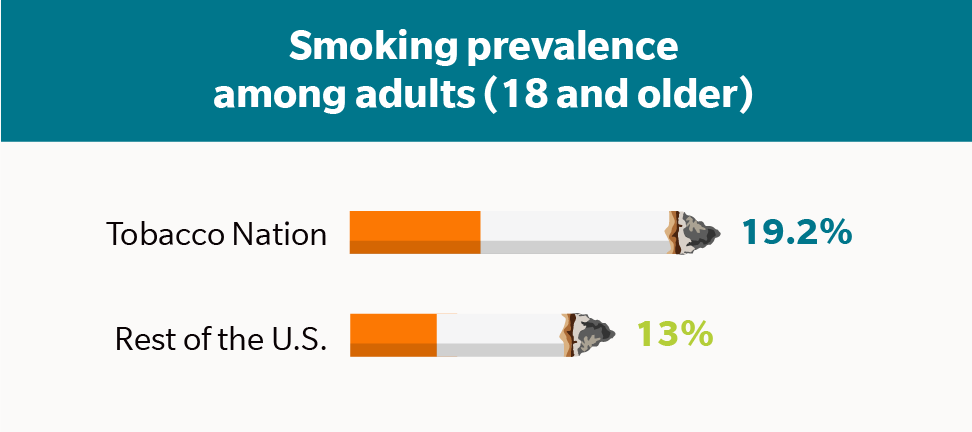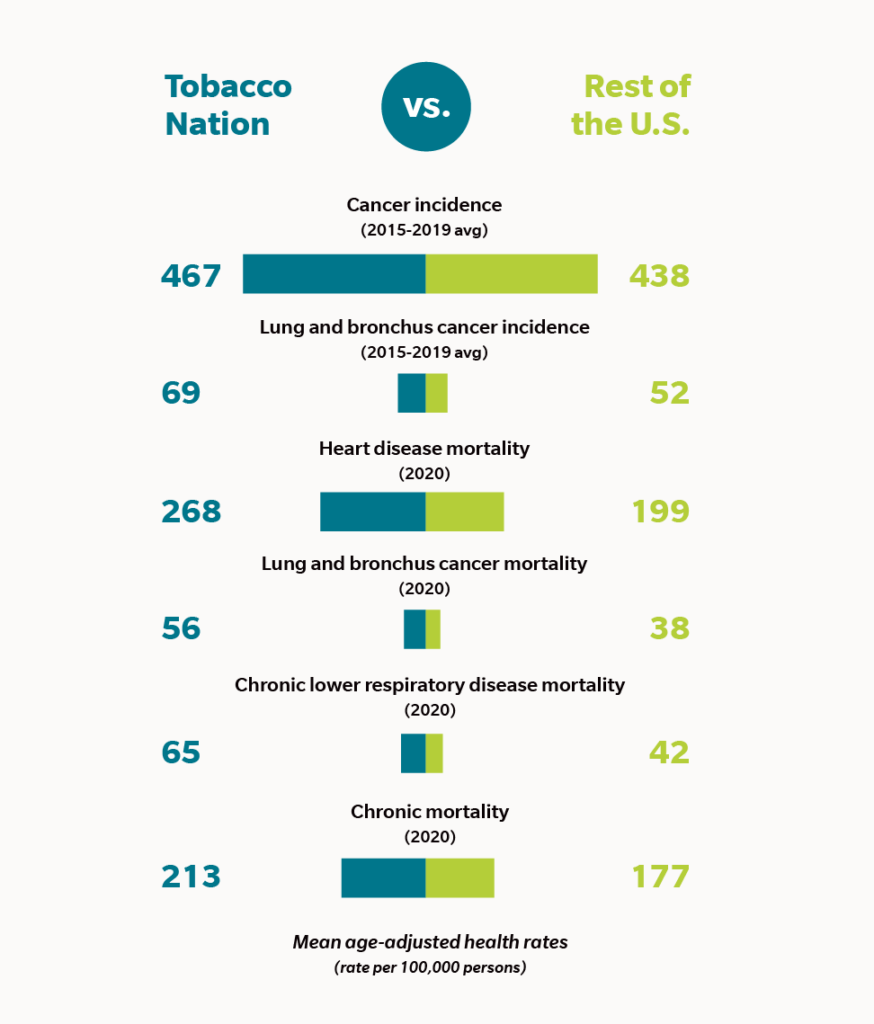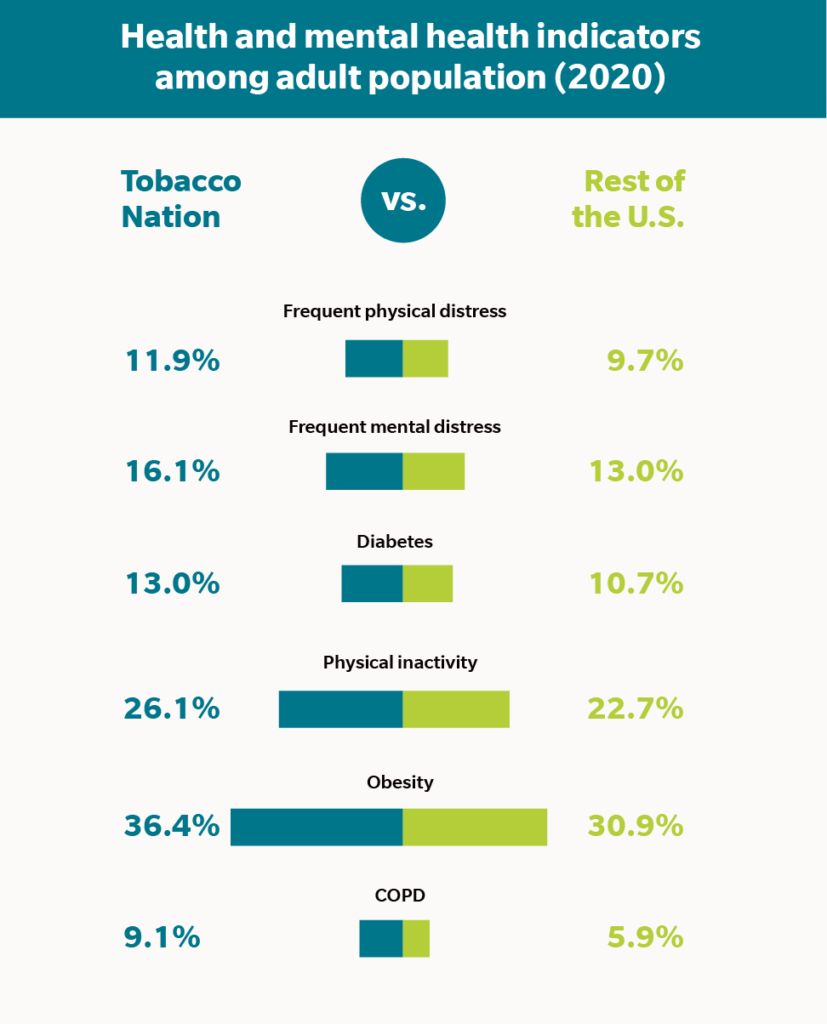When we participated in the Biden-Harris Administration’s Cancer Moonshot Smoking Cessation Forum last June, one priority was front and center throughout the meeting: the need to eliminate the marked disparities in smoking-related morbidity and mortality.
Certain populations and communities are still disproportionately impacted by smoking and critically need support to quit tobacco.
This is the same finding from our recent report on a region referred to as “Tobacco Nation.” Tobacco Nation spans Alabama, Arkansas, Indiana, Kentucky, Louisiana, Michigan, Mississippi, Missouri, Ohio, Oklahoma, Tennessee, and West Virginia. In these 12 states, adults have a 50% higher smoking prevalence than the rest of the U.S. population.

But it doesn’t need to be this way.
Here’s what employers can do to change this costly trend for employees who use tobacco in these communities.
Impact of tobacco use
Research has long shown the connection between cancer and cigarette smoking: tobacco use can be linked to at least 12 different types of cancer, and one-third of cancer deaths are caused by smoking.
In Tobacco Nation specifically, the impact of higher tobacco use takes its toll. Residents of these 12 states live shorter lives and face a higher risk of dying than other Americans, with an average life expectancy of 76 years compared to 79 years in the rest of the U.S.
More smokers in Tobacco Nation also suffer from other health conditions that accompany tobacco use compared to the general adult smoking population, and employers bare the brunt of these healthcare costs for treatment.
Unsurprisingly, smokers in Tobacco Nation report much higher rates of frequent physical distress, diabetes, poor physical health days, physical inactivity, and chronic obstructive pulmonary disease compared to the total adult population.
Looking ahead, adult smoking prevalence in Tobacco Nation states is forecasted to be over 40% higher on average compared to other U.S. states over the next 20 years—unless some things dramatically change.
Why some communities struggle more than others with tobacco use
Tobacco control policies are proven to substantially reduce cigarette smoking in the U.S. in the past 2 decades. However, these policies—which include increased cigarette taxes, smoke-free air laws in workplaces, and quitting tobacco interventions—have not been adopted equally across the U.S.
This is especially true in Tobacco Nation:
- States within Tobacco Nation have less restrictive tobacco control policies compared to much of the nation. For example, our study found that lower taxes in Tobacco Nation lead to a pack of cigarettes costing nearly 20% less there than in other states ($6.50 compared with $7.95).
- Tobacco Nation states also spend about half as much on prevention and cessation efforts. These 12 states spend less than 15% of the CDC-recommended amount on tobacco prevention and cessation programs compared to 30% of CDC-recommended spending on these efforts outside of Tobacco Nation.
Prevention, cessation, and policies can make a significant difference
An analysis by Truth Initiative and HealthPartners Institute found that increasing spending on tobacco prevention and cessation programs, paired with raising the cost of cigarettes, could reduce adult smoking disparities in Tobacco Nation to levels on par with the rest of the country.
The analysis predicted that these controls over the next two decades could lead to:
- Roughly 100,000 fewer cancer cases;
- 730,000 fewer hospitalizations;
- Savings of over $24 billion in smoking-attributable medical costs; and
- Increased productivity by over $100 billion.
Time to act is now
Tobacco cessation remains one of the most cost-effective interventions for saving and improving lives, with a large return on investment.
Employers in high-tobacco use states have an important role to play in funding effective tobacco cessation programs and driving engagement in these programs to change the current costly trajectory.
And the EX Program can help you make a difference.
We bring unparalleled expertise in how to best engage adults in quitting smoking, vaping, and nicotine to help improve the health of your workforce.
See more about how the EX Program works for you to do this on our Employers page.
To see more information about Tobacco Nation and the impact on employers in these 12 states, download our report available here.






